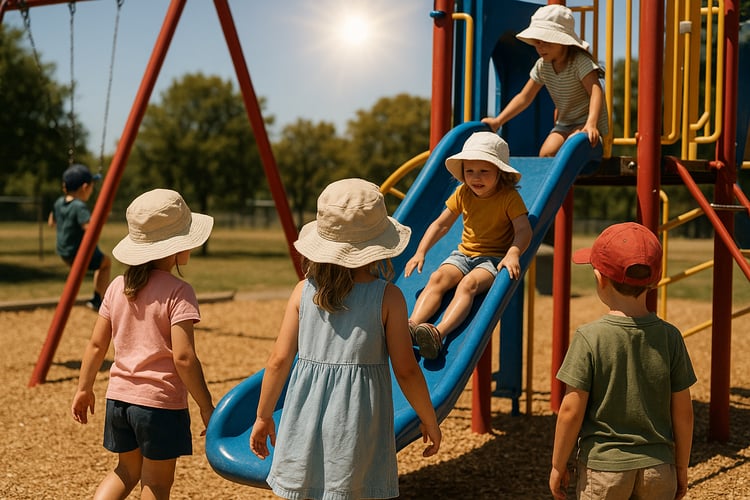Children need the sunshine for healthy bones and their well-being but too much sun can cause sunburn and sunstroke.
It can be a hard balancing act especially during the holidays and summer term when all children want to do is play outside with their friends.
This balancing act is also tricky for parents whose teenage children spend much of their time on their screens playing computer games and are reluctant to go outside.
Unfortunately, rickets, a Victorian disease connected to a lack of Vitamin D has made a comeback to the UK partly due to poor diet and not getting enough sunshine.
Getting enough time in the sun
Researchers at Manchester University studied the link between the sun and Vitamin D and concluded that people with lighter skins need at least 10-15 mintues of sunshine to be able to synthesize Vitamin D while their darker skinned peers need from 25-40 minutes exposure.
The large scale study found that exposure for these short periods is best without sunscreen with forearms, hands and lower legs uncovered.
However, for children on very hot days it’s best to avoid the sun between 11am and 3pm and keep inside or in the shade.
Childhood sunburn and skin cancer
More people in the UK now die of skin cancer in Australia with 17,500 new melanoma cases – the most dangerous type of skin cancer - every year.
Skin cancer has become the fifth most common cancer and the evidence shows that getting sunburnt in childhood or as a teenager more than doubles your chances of developing melanoma skin cancer later in life.
Heat exhaustion and heat stroke
Like older people and those with underlying health conditions, hot sun affects children more adversely because they can’t regulate their body temperature as well as adults.
Children’s sweat glands aren’t fully developed and they absorb more heat which makes it more difficult for them to cool down and to suffer heat exhaustion, leading to the more serious heatstroke.
They may not recognise what is wrong with them and find it hard to explain how they feel although key signs are visible discomfort, irritability, nausea, vomiting and tiredness.
A teaspoon of suncream and covering up
The best way of reducing children’s chances of developing melanoma or getting heatstoke is to prevent it from happening.
Go for at least SPF 30 and try to apply a teaspoon of suncream per body party 30 minutes before going out into the sun. The UK’s Melanoma Focus recommends reapplying it every two hours or after activities like swimming.
The charity also points out there is hardly any difference between the two highest SPF filters; SPF50 blocks out 98 per cent of UV radiation compared to 96.7 per cent by SPF30.
It also warns of claims made by ‘one application’ sun creams as these have only been tested in lab conditions.
Dress children in loose close weave clothing such as long sleeves, trousers and dresses and wide brimmed hats.
Bring out the shade
As we experience more frequent heatwaves, many schools are opting to introduce sail shades or canopies into their playgrounds so children can still enjoy the outside when it’s hot.
Spaceshade has provided affordable and versatile shade to many different schools across the country as our many case studies demonstrate.
The shade sails come in different shapes, sizes and cheerful colours creating a striking design to playgrounds while the canopies can be modified as covered walkways, outdoor learning canopies and installed over courts for sports.
If you’d like to find out more about our range of shade sails and canopies, contact us.




.jpg?width=600&height=400&name=Paddock%20SEND%20School%20-%20Spaceshade%20canopies%20with%20post%20protectors%20(6).jpg)
